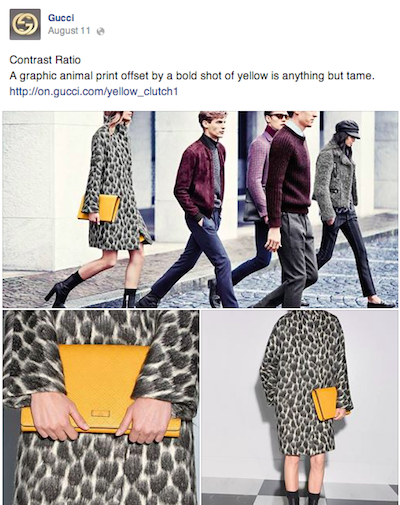 Dolce & Gabbana's headphones
Dolce & Gabbana's headphones
Italian fashion labels Dolce & Gabbana and Versace are the only brands to rank in the top 10 among luxury retailers across social media platforms and offline, according to a report by Engagement Labs. Engagement Labs tabulated eValue and TalkTrack scores for the online and offline performance, respectively, of luxury brands, but success on one channel did not translate to universal victory. Word of mouth used to be the hallmark measure of desirability, but social media has recently begun to take on the same significance, although online and offline desirability do not always correlate, presenting brands an opportunity to align marketing efforts with multichannel retailing. "Offline and online word of mouth are both strong purchase drivers," said Bryan Segal, CEO of Engagement Labs. "A recent study by Word of Mouth Marketing Association (WOMMA) states that two-thirds of the sales impact comes from offline, and one-third comes from social media. "An average of 13 percent of consumer sales is driven by word of mouth, as measured by Keller Fay Group’s TalkTrack in higher price-point categories word of mouth’s impact is almost 20 percent of sales," he said. On and off French shoe brand Christian Louboutin ranked first on Facebook engagement, leading the pack in engagement and responsiveness to edge out jeweler Tiffany & Co. Frequent short posts, professional photography and consistent branding with #LouboutinWorld led the brand to outpace its competitors in likes and shares per 1,000 fans.
//Ladies, place your bids! It's the last day to nab an exclusive red Paloma on eBay. Let's #endAIDS with (RED). http://ebay.to/1kEvJFV Posted by Christian Louboutin on Thursday, December 10, 2015
Psst! It's not too late to #DropAHint. Head to https://t.co/mJbMcdeSTs and we'll take care of the rest. pic.twitter.com/NDvdECVLwn
— Tiffany & Co. (@TiffanyAndCo) December 10, 2015
In general, luxury brands engage less on social media than mass-market brands. On one hand, this means they are missing out on opportunities to engage an audience; on the other, a lack of engagement from a luxury brand could help create an aura of desirability and elite status that mass brands could not create.
"When looking at other luxury categories such as cars, we found that there is a pattern these brands have by showing less engagement with consumers online," Mr. Segal said. "So, this can very well be a strategy to maintain desirability. However, as social media continues to evolve and consumers look more and more to social channels as a customer service platform, brand strategies must also evolve to balance consumer demands and expectations."
Psst! It's not too late to #DropAHint. Head to https://t.co/mJbMcdeSTs and we'll take care of the rest. pic.twitter.com/NDvdECVLwn — Tiffany & Co. (@TiffanyAndCo) December 10, 2015
Online success generally did not translate to offline success and vice versa.
Gucci led in word of mouth, placed eighth in Twitter and edged into Facebook’s tenth place but missed ranking on Instagram. Second-place Coach ranked on Instagram at ninth, Ralph Lauren was third but missed Facebook and Twitter and Calvin Klein featured on three lists, including ranking second on Instagram, but missed the top 10 for Facebook.
Dolce & Gabbana and Versace were the only brands to feature on all four lists. Dolce & Gabbana finished sixth in Facebook, Instagram and offline word of mouth and ninth on Twitter, while Versace ranked third on Facebook, fifth on Instagram, sixth on Twitter and tenth on offline word of mouth.
 Gucci pre-fall 2014 Facebook
Today, the consumer no longer differentiates between online and offline as sharply as she did just a few years ago. It might benefit marketers to ensure that they are reaching consumers both online and offline, particularly as more resources are geared toward providing a multichannel shopping experience. Staying active and visible in both spaces will keep the brand at top of mind regardless of where the shopping is being done.
Other markets
Similarly, success online among hospitality brands does not always generate in-person word of mouth.
The Ritz-Carlton Hotel Company leads online conversation among hospitality brands in the United States, according to an August 2015 report by Engagement Labs.
While word of mouth is still important among high-end goods and services, online conversation, hashed out on social media platforms such as Facebook and Twitter, is steadily becoming a strategy for brands aiming for consumer retention. In Engagement Labs’ first “Total Social” ranking, Ritz-Carlton ranked the highest on social media, but fell when it came to recommendations made by offline word of mouth, presenting an opportunity for the hospitality brand (see story).
Unlike the apparel industry, however, the automotive industry sees luxury brands being just as active on social media as mass-market brands.
German automaker BMW and U.S. electric automaker Tesla Motors are the two top automotive brands on Twitter and in generating offline word of mouth momentum, according to Engagement Labs.
Chevrolet Corvette took the top spot in the two remaining categories—offline word of mouth sentiment and Facebook use—but a number of luxury automakers placed in the top 10 in at least one of the four categories. Luxury brands are generally thought to be slow adopters of digital technology, but the October findings prove that is not always the case (see story).
"Success on one channel does not necessarily translate to success on another," Mr. Segal said. "Different social media channels serve different purposes; therefore, brands need to understand how audiences engage differently with each channel as well as understanding what type of content should be posted on each.
"For example, Facebook is highly used for news and information; therefore, your brand should post content that followers would be interested in reading - promotions, new CSR initiatives, videos of your product in use, etc," he said. "On the other hand, Instagram is a highly visual platform that many use for inspiration, in this instance a medium for luxury brands to showcase interesting and professional images with a goal of inspiring your audience to buy-in."
Similarly, success offline does not necessarily translate to success online and vice-versa. As a result, brands need to be aware of how they are being talked about in both mediums and determine strategies that can amplify conversations in both areas. A recent study from Analytics Partners and Keller Fay Group found that when advertising causes conversations and online sharing, it is much more likely to also drive sales, compared to when it does not drive conversation.
"Additionally, the quality of the creative is more effective at driving consumers to talk about a brand than the amount of airtime or ad spend the TV campaign received. For that reason, brands need to carefully look at the content they are disseminating both online and offline and determine if it is driving conversations that are leading to sales."
Final Take
Forrest Cardamenis, editorial assistant on Luxury Daily, New York
Gucci pre-fall 2014 Facebook
Today, the consumer no longer differentiates between online and offline as sharply as she did just a few years ago. It might benefit marketers to ensure that they are reaching consumers both online and offline, particularly as more resources are geared toward providing a multichannel shopping experience. Staying active and visible in both spaces will keep the brand at top of mind regardless of where the shopping is being done.
Other markets
Similarly, success online among hospitality brands does not always generate in-person word of mouth.
The Ritz-Carlton Hotel Company leads online conversation among hospitality brands in the United States, according to an August 2015 report by Engagement Labs.
While word of mouth is still important among high-end goods and services, online conversation, hashed out on social media platforms such as Facebook and Twitter, is steadily becoming a strategy for brands aiming for consumer retention. In Engagement Labs’ first “Total Social” ranking, Ritz-Carlton ranked the highest on social media, but fell when it came to recommendations made by offline word of mouth, presenting an opportunity for the hospitality brand (see story).
Unlike the apparel industry, however, the automotive industry sees luxury brands being just as active on social media as mass-market brands.
German automaker BMW and U.S. electric automaker Tesla Motors are the two top automotive brands on Twitter and in generating offline word of mouth momentum, according to Engagement Labs.
Chevrolet Corvette took the top spot in the two remaining categories—offline word of mouth sentiment and Facebook use—but a number of luxury automakers placed in the top 10 in at least one of the four categories. Luxury brands are generally thought to be slow adopters of digital technology, but the October findings prove that is not always the case (see story).
"Success on one channel does not necessarily translate to success on another," Mr. Segal said. "Different social media channels serve different purposes; therefore, brands need to understand how audiences engage differently with each channel as well as understanding what type of content should be posted on each.
"For example, Facebook is highly used for news and information; therefore, your brand should post content that followers would be interested in reading - promotions, new CSR initiatives, videos of your product in use, etc," he said. "On the other hand, Instagram is a highly visual platform that many use for inspiration, in this instance a medium for luxury brands to showcase interesting and professional images with a goal of inspiring your audience to buy-in."
Similarly, success offline does not necessarily translate to success online and vice-versa. As a result, brands need to be aware of how they are being talked about in both mediums and determine strategies that can amplify conversations in both areas. A recent study from Analytics Partners and Keller Fay Group found that when advertising causes conversations and online sharing, it is much more likely to also drive sales, compared to when it does not drive conversation.
"Additionally, the quality of the creative is more effective at driving consumers to talk about a brand than the amount of airtime or ad spend the TV campaign received. For that reason, brands need to carefully look at the content they are disseminating both online and offline and determine if it is driving conversations that are leading to sales."
Final Take
Forrest Cardamenis, editorial assistant on Luxury Daily, New York
